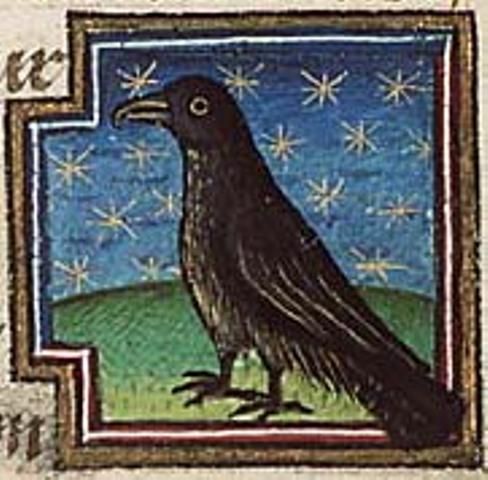















The Deceiving of Huan
Peniarth MS 112 880-881
Gwraig Huan ap Gwydion, a vu un o ladd ei gwr, ag a ddyfod ei fyned ef i hely oddi gartref, ai dad ef Gwdion brenhin Gwynedd y gerddis bob tir yw amofyn, ac or diwedd y gwnaeth ef Gaergwdion (sef: via laactua( sy yn yr awyr yw geissio: ag yn y nef y cafas ei chwedyl , lle yr oedd ei enaid: am hynny y troes y wraig iefanc yn ederyn, a ffo rhag ei thad yn y gyfraith, ag a elwir er hynny hyd heddiw Twyll huan.
The wife of Huan1 ap Dôn2 was a party to the killing of her husband, and she said that he had gone to hunt away from home. And his father, Gwydion, the King of Gwynedd, traversed all countries in search of him, and at last made Caer Gwydion3, that is the via lactea, which is in the sky, to seek him. And he found him in heaven, where was his soul. And for that he turned the young wife into a bird and she fled form her father-in-law, and is called to this day Twyll Huan4. Thus, after the manner of the Greeks, the Britons formerly treated their stories and tales in order to keep them in memory.
NOTES
1. Huan ap Dôn: the figure here is obviously Lleu Llaw Gyffes, and this short text is a retelling of the final section of the Mabinogi; why his name is Huan, "Sun," is a difficult question (see note 3). "Lleu" is certainly derived from Lugh, in which the "gh" is essentially silent; Lugh is in turn derived from "Lugus", which ultimately derives from the hypothetical proto-Indo-European *Leug- "oath/swear." In other words, he is originally the god of the oath, Dumezil's Mitra to Nuada's Varuna. Thus, Lleu was not originally a god of light; however, the similarity between *leug- (oath) and *leuk- (light) may have influenced the idea that Lugus (and thus Lugh and Lleu) was somehow associated with light, at least in late Iron Age/early medieval thought.
2. Huan/Lleu's pedigree here is confusing, as traditionally his mother is Arianrhod, making Dôn his grandmother. Moreover, Gwydion is also the son of Dôn, and so Lleu/Huan would be the product of Gwydion's incest, either with his sister or his mother; the sister is more likely.
3. Caer Gwydion: there is some tradition that the Milky Way is called Caer Wydyon in Welsh; whether this is actual medieval tradition, or influenced by the antiquarians, I am not sure.
4. Twyll Huan: The story is an attempt to explain the word tylluan, the owl. In this bit of folk etymology, tylluan is divided into twyll "deceive" and (h)uan, the sun. Thus, the composer changed Lleu's name to Huan, which he may have thought fitting.
SOURCES
Jones, T. Gwynn. Welsh Folklore and Folk-Custom. London: Methuen & Co. LTD, 1930. p.16.
Williams, G. Math vab Mathonwy.